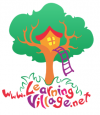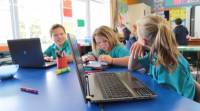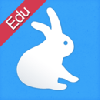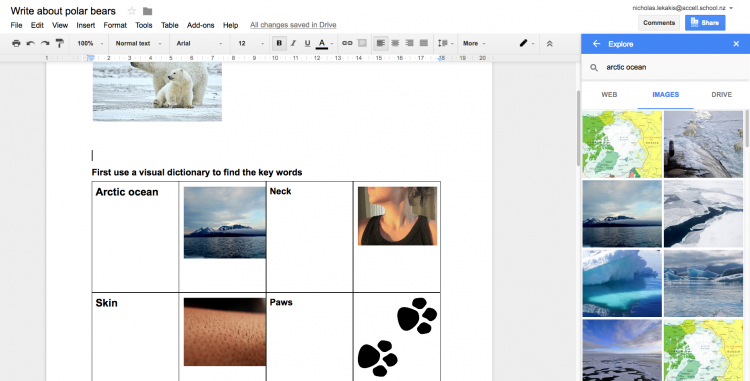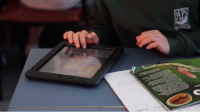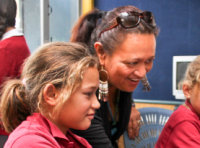Supporting English language learners through digital technologies
Who are English Language Learners (ELLs)?
Many students in schools come from diverse backgrounds and linguistic environments. These bilingual and multilingual students represent a significant proportion of many school populations, and may need English language support.
They could include:
- NZ-born students – including Pasifika
- students from migrant backgrounds – including Pasifika
- students from refugee backgrounds
- Māori and Pasifika students in bilingual education settings or transitioning into English medium schools
- international fee paying students.
Why use digital technologies to support learning?
Integrating digital technologies into learning and teaching helps English language learners acquire a second language, and enhances motivation and confidence.
English language learners benefit from the reinforcement of vocabulary and concepts through pictures, graphics and video. They also benefit from being able to use technology to express themselves. Technology helps English language learners find a voice, easing the transition to a new language.
Acquiring a new language
It is important to understand how students acquire a new language in order to appreciate the significance that digital technologies can have in ensuring success for English language learners.
It can take more than five years for the average child learning a new language to acquire the academic language necessary to succeed in school. Successful acquisition requires two types of skills:
- Basic Interpersonal Communication Skills (BICS) – social or conversational language
- Cognitive Academic Language Proficiency (CALP) – the academic language needed to comprehend and analyse a textbook or understand a presentation by a teacher.
This distinction explains why it often appears that some English language learners have a better grasp of English than they actually do.
“Conversational fluency is often acquired to a functional level within about two years of initial exposure to the second language, whereas at least five years is usually required to catch up to native speakers in academic aspects of the second language” (Cummins, 2000, p. 76). By using multimedia technologies to incorporate pictures or video into the lesson, teachers can provide students with the necessary contextual cues to understand new concepts. Visual information can provide the necessary scaffold between everyday language and more difficult academic language (Cruz, 2004). Digital technologies allow students to show what they have learned in multiple ways — offering a more accurate assessment of their growth.
Supporting English language learners through technology
Key resources and support
ESOL Online on TKI – provides support and guidance with:
- funding and programmes for ELLs
- planning for my students needs – PLD, resources, teaching and learning sequences
- teaching strategies – teaching strategies for oral language, reading, writing, vocabulary, and thinking
- student needs – tools and resources for assessing your student's English language learning progressions (ELLPs).
Ministry of Education information and resources to support funding, programme provision and monitoring, connecting with the community, PLD, teaching literacy.
The Learning Village NZ
This online ESOL programme is available to intermediate and secondary schools. It supports students who are new learners of the English language to develop the language skills to participate in the classroom.
Students and schools will be identified from the Ministry ESOL funding database, and the Learning Village NZ team will invite them to join the programme. Schools enrolled in the programme through the Ministry of Education will receive comprehensive training and ongoing support from a team of New Zealand staff. This includes upskilling teachers and teacher aides to integrate Learning Village lessons with students’ curriculum subjects.
Schools that think they might be eligible for the programme are also welcome to contact the providers directly.
- Email: [email protected]
- Tel: 09 889 8153
Using digital technologies to support ESOL principles
ESOL online outlines seven principles for teaching and learning that enable your students to make both academic and language progress across the curriculum learning areas. The ESOL principles, and your knowledge of your students, should guide your planning and teaching.
Utilising and combining images, video, and audio is an effective way to engage, support, and motivate English language learners.
Principle 1: Know your learners
Know your learners – their language background, their language proficiency, their experiential background
- What do you know about your students' language skills?
- What do you know about their prior knowledge?
- How will you find out this information?
- How will it affect your planning?
Tips and tools
Students sharing where they are from – using maps and digital stories
Digital technologies provide opportunities for students to share about themselves, their families, and where they are from. Because content is recorded and shared, it is useful to assess their prior knowledge and language skills, and inform planning.
- Getting started with Google Maps – instructions for using Google Maps to add text, images, and videos about specific locations. Use for students to share information and practice giving directions.
- Using Google Maps for ESOL – ideas for using maps to support dialogue.
Digital stories
Digital storytelling enables ELL students to draw on their cultural strengths and background experiences. Students can use pictures from home, downloaded pictures about their cultures, and music. Encourage students to develop a narrative about themselves, their families, their culture, or other things that are important to them.
- Google slides or Powerpoint
- Voicethread
More information »
Principle 2: Identify the learning outcomes
Identify the learning outcomes including the language demands of the teaching and learning
- What language do the students need to complete the task?
- Do the students know what the content and language learning outcomes are?
Tips and tools
Flipped learning
By recording and narrating screencasts of learning tasks that use simple language and clear illustrations, students are supported to understand what they are learning and how to be successful.
Tamaki College maths teacher, Noelene Dunn has set up a Google site for her students to support a flexible and inclusive approach to learning. She and her students explain how they use it. Students value having "a lot of different activities to choose from, everyone can do what they like to do”.
More information »
Principle 3: Maintain and make explicit the language outcomes for learners
Maintain and make explicit the same learning outcomes for all the learners
- How can I make the lesson comprehensible to all students?
- How can I plan the learning tasks so that all the students are actively involved?
- Do my students understand the learning outcomes?
Tips and tools
Provide clear models
Provide explanations and examples of what students are required to do for each lesson. Ensure these are online so students can return to them as often as they need to. This could be made available on a Google site , Weebly , or on a Google document.
Use online brainstorming tools that students can all contribute to
- Padlet – an easy-to-use and effective way of sharing student ideas, brainstorming, and collaborating.
- Popplet – a brainstorming tool, available as an iPad app or on the web.
Plan collaborative activities so all students are actively involved
Students can work together on a range of tasks using technologies including:
- Presentation tools such as Prezi , or Google slides
- Collaborative writing tools such as Google docs
- Online games
- Video creation
More information »
Principle 4: Begin with context embedded tasks
Begin with context-embedded tasks, which make the abstract concrete
- How can I put these concepts into a concrete context?
Tips and tools
Use language experiences to support speaking and writing
Teacher, Bridget Harrison shares how her students are taking photos of experiences in the classroom and developing digital stories to scaffold the writing process. The stories can be used for reading material by the students.
More information »
Principle 5: Provide multiple opportunities for authentic language
Provide multiple opportunities for authentic language use with a focus on students using academic language
- Is the language focus on key language?
- Do I make sure the students have many opportunities to notice and use new language?
Tips and tools
Provide clear models with a range of learning opportunities for practice
In this example, a Voicethread has numbers from 1-20 written, illustrated, and recorded. Students can return to this as often as they need to. Students can practice their recognition of numbers through playing a game such as Numbers , from the Games to Learn English website.
More information »
Principle 6: Ensure a balance between receptive and productive language
Principle 7: Include opportunities for monitoring and self-evaluation
- Am I using "think alouds" to show students my strategy use?
- What opportunities are there for reflection and self-evaluation?
Tips and tools
Reflection and evaluation based on success-criteria
Provide opportunities for students to record and listen to themselves, or write and receive feedback. They can work collaboratively to give each other feedback and evaluate their own progress.
- Voicethread – Create and share dynamic conversations around documents, images, diagrams, and videos. You can talk, type, and draw on the screen.
- Google docs – Using the comments function students can give and receive feedback.
Irongate School teacher, Marion Croad, describes the improvements in her New Entrant students' written and oral language as a result of using Photostory. The majority of the students are Māori and Pacific Islanders with English as a second language. Using a tuakana-teina approach students worked alongside a Year 5/6 buddy who supported them with their learning. She found the students' oral language improved – both in terms of enunciation and sentence structure. Using the storyboard to plan their story sequence led to a development in the number of sentences written.
More information »
Supporting writing using digital technologies
Developing ELL writing requires the promotion of a number of different skills and qualities, including:
- writing fluency
- text cohesion
- grammar and accuracy.
Collaborative writing
Writing collaboratively supports ELL students to work at a level higher than what they are able to manage on their own. Use a tuakana teina approach, pair more advanced students with those just beginning.
Writing together or reconstructing texts in groups or pairs:
- reduces anxiety around output
- creates an opportunity for students to gain immediate feedback from their peers
- provides a chance to develop oral language
- is linked to increased confidence.
Students learn from each other when they write collaboratively.
Tools for collaborative writing
Google applications for education (GAFE)
Designing collaborative tasks in a google doc or slide presentation allows your students to work collaboratively in real time from their devices. GAFE allows teachers to monitor and support the work of multiple students in real time from their devices.
ePals is a website that helps students from around the world find each other and collaborate on projects. The site boasts a range of tools to help students communicate through chat forums, messaging services, shared blogs, and galleries. It has project templates designed to fit in with a wide range of curricula, and tools to help student groups create their own projects to collaborate on.
Tips and ideas for collaborative writing
Collaborative writing activities
In this blog post, Rachael Robits explains some engaging exercises to foster collaborative writing.
Collaborative story telling
Larry Ferlazzo on Edutopia writes about how collaborative fiction writing can improve outcomes for ELLs.
Combing Dictogloss and cooperative learning to promote language learning
In this paper, George Jacobs discusses how dictogloss – a fresh play on dictation tasks – can foster cooperative learning as students and teachers work together to reconstruct texts.
Language experience approach
A language experience approach (LEA) is centred around learner-generated text describing a shared experience. Student writing can then be used as reading material. Materials with familiar vocabulary and ideas are more meaningful and accessible than texts found in pre-prepared books. Digital tools support the development and sharing of this material.
- A shared experience – The LEA process begins with something the class does together, such as a field trip, an experiment, or some other hands-on activity. Take pictures of the experience, these can be grouped into beginning middle and end or sequenced by the students.
- Create the text – The teacher and students, as a group, verbally recreate the shared experience. Students take turns volunteering information, as part of a group discussion. The teacher can transcribe the student’s words to create the text, or the students can work collaboratively to create their own text. Using PowerPoint, Google slides, or some type of book creator software students can put an image on each slide in sequence and use this to support their writing.
- Read and revise – Either as a class or in pairs, students re-read the story aloud and discuss any changes.
- Read and reread – The final stories can be read in small groups or pairs, and then individually.
Bridget Harrison's class at Kimi Ora Community School is made up of 100% Māori and Pasifika students. Many of the students have English as a second language. In this clip she shares how they are using digital stories to scaffold the writing process using a language experience approach.
She found, having them make a digital story about a shared experience formed a language base for oral language with the students because they could talk about it. The students could speak to each other in Samoan and Tongan, talk about the pictures, and describe the experience.
To support sequencing she had the students take photographs of their language experiences and put them in folders for ‘beginning’, ‘middle’ and ‘end’. The students could select the photos that they wanted and write their stories. Having students give each other feedback as they read their writing aloud supported them to work together to build their language skills. By creating digital stories and turning them into audio books, they created resources which were student owned, and able to be reused.
The success of this approach is reflected in their asTTle writing data showing students making a year's progress in two terms.
Tools for creating digital stories
Students can combine text, images, audio, and video to create stories that can be shared.
Using Google Slides, students can create, edit, collaborate, and present for free. Slideshows can be stored in the cloud and accessed anywhere, anytime.
Students can make presentations and slideshows from photos, videos, sound clips, and voiceovers. They can start a new presentation, select their library of visual content, add animated text and background music and then record themselves going through the presentation, commenting on the images in front of them. Presentations can be saved to the local device and to the cloud.
An up-to-date list of apps that can be used across both platforms (iPad and Android). The apps have been reviewed by teachers and are for all age groups.
Tips and ideas
Making digital books google slides
This blog post outlines how to create an ebook with Google Slides and how to share it with others. Students can go on to create a digital reading library on the iPad made up of student stories by making QR codes.
In this video, Bridget Harrison describes how her students created bilingual digital stories and the confidence they developed from having their culture valued through sharing in their own language as well as learning English.
Writing for authentic audiences
Digital tools enable students to easily share their writing with peers, the school community, whānau, and a wider audience across the web. Having an authentic audience gives students a purpose for writing and is linked to enhanced creativity and motivation for self-editing.
Tools and websites for sharing writing with wider audiences
Blogs
Free to use blogging platforms like Blogger
can be a great way for ELLs to share writing with wider audiences. A digital alternative to the writing journal, blogs can be an effective way for ELLs to share writing with friends and whānau living overseas. Readers can also easily add comments and provide essential feedback on student work.
ePortfolios
Easy-to-use website builders like Google Sites
and Weebly
make it possible to create e-portfolios of student work that can be easily shared with whānau.
Padlet
Padlet
is an easy-to-use and effective way of sharing student writing with the class. It is basically a virtual whiteboard – a convenient tool for sharing ideas, brainstorming, and collaborating beyond the classroom.
Tips and ideas
The best places where students can write for an authentic audience
This article by Larry Ferlazzo on Edublogs has a comprehensive list of tools and websites designed to help ELLs connect with a wider audience.
Online publishing and authentic audience to improve student writing
This doctoral thesis by Lori M. Weider at Northeastern University looks at how the use of technology, on-line publishing, and authentic audience affects student writing.
Developing writing fluency
The blank page can intimidate anyone about to start writing. For ELLs, the feeling of writer's block can be compounded by language barriers, fear of making errors, and searching for vocabulary.
Use digital tools to help ELLs to feel more engaged and supported in writing. Offer templates, art, and images to inspire and organise ideas.
Susan Lee, teacher at Te Kura o Kutarere shares how using Storybird, a free digital story writing tool, in her classroom has made a significant impact on the literacy development of her students. She describes how students have become self motivated and proud of their work. Using Storybird has meant reluctant writers are now, "constantly reading their own work and reading other students stories".
Tools for developing writing fluency
Storybird uses art and book templates to inspire students to write and make stories. Teachers can create and track activities to support developing writing fluency. Stories can be shared and published, connecting students to wider audiences.
Create a comic strip or storyboard using the editing tools.
Graphically organise student writing into infographics using this tool.
Visual dictionaries
Visual dictionaries are useful tools to support students' understanding of specific situations or topics and to build their vocabulary of nouns.
A visual dictionary shows the meaning of a word through a picture, photograph, or diagram. Usually, they are arranged by topic. This allows students to see an object in its context and make stronger associations with other words.
Create a visual dictionary
Create a Google doc, and use the "Explore" tool to find images that illustrate words. Teachers can create a shared visual dictionary that is developed with students to support specific lessons.
- Support writing by including images related to key vocabulary – Visual dictionary example for games and sports
- Provide words and encourage students to find the images using the "Explore" tool in Google Docs, then go on to use them in their writing about a particular topic.
Developing grammar and accuracy
While it is not recommended you run students through endless grammar drills, supporting students to understand and practise some basic rules can help make English clearer in their minds. Ensure you embed this learning in authentic contexts.
There is a wide range of online tools designed to help students improve their grammar and language accuracy.
Tools for practising grammar and language accuracy
BBC English is a free website with integrated lessons based on news items. Lessons are organised from beginner to advanced levels. Lessons typically incorporate a range of skills including reading, listening, writing, and speaking. Crucially, they also include a focus on a particular grammar item or language structure.
British council: Learn english for kids and teens
The "Learn English" sections of the British council website provide comprehensive and free digital resources for learners of English. They contain hundreds of grammar lessons and activities designed for child and teen audiences.
ESL games world
Has interactive games for ELLs that support a comprehensive range of grammar and vocabulary points.
Grammar monster
This website has comprehensive lessons on points of grammar and punctuation that are followed by tests and practise activities.
Agenda web
Agenda web pulls together a collection of online links to activities designed to test specific grammar points.
EnglishClub
Has a range of free online grammar activities.
Digital tools for developing reading and vocabulary
Reading is a complex skill. For ELLs, becoming a fluent reader in English can be particularly challenging, especially if they are not used to reading in their first language.
Select reading materials according to ability
When looking for reading materials, it is essential that texts challenge your ELLs without intimidating them. For older students, it can be difficult to find texts that students can relate to, which stretch a students' skills while remaining accessible to their language level. Fortunately, there are digital tools available to help you grade and differentiate reading for each student's individual language ability.
Digital tools for graded reading
The instructional series has an extensive range of guided readers, graded for different reading and literacy levels. The reading materials support literacy learning across the New Zealand curriculum. Teacher support materials and audio books are available to be downloaded and streamed from the website.
For a small subscription fee, Raz-Kids gives students access to a large collection of graded e-books containing appealing illustrations and audio-narration. Teachers can set up classrooms and allocate books according to student reading ability. Built-in analytics and running records help teachers monitor student progress.
Especially effective for older learners, Newsela contains hundreds of articles that relate to current affairs and contemporary global issues. Each article can be graded in difficulty from simple lexile level to advanced, making it a perfect tool for differentiating learning with a class of varying abilities. It's free to use, but has a PRO membership option for added features.
Contains integrated lessons built around graded resources, which are based on news and current affairs. Materials are graded in 7 levels, from beginner to advanced.
More information »
The Lexile framework for reading
This website has links to reading programs based on lexile measuring. Lexile measure is a way of matching readers to texts according to ability. There are a number of reading programmes based around this framework for use by educators.
Follow up reading with comprehension tasks
Responding to a text through comprehension tasks like quizzes and summaries will encourage your students to read a text closely. Tasks that test understanding and provide your students with opportunities to practise skills like inferring meaning from context will help them engage in higher-order thinking and knowledge-building.
Digital tools for developing reading comprehension
Raz-Kids , Newsela , Breaking News English , and British Council Reading all contain reading texts accompanied by effective comprehension tasks that help students check understanding, develop reading strategies, and build vocabulary.
Develop phonics
Phonics – or the relationship between sounds and their corresponding letters – is an integral skill to develop among ELLs learning to read. To understand written texts, ELLs must be able to relate the sounds they hear in spoken language to the letters on the page.
Digital tools for developing phonics
Pitched to younger learners, Starfall is a free-to-use reading tool with a particular focus on phonics. Starfall gradually challenges students by starting with the basic sounds of the letters in the alphabet, and then moving onto book-reading. The activities are engaging and interactive, providing students with multiple means of practising an area of focus.
Fast Phonics is a free website for both younger and older audiences. Audio and images help students practise sounds and letter blends.
This online tool is has been designed for older learners of English to practise their phonics.
Build vocabulary
Developing vocabulary is essential for any learner's academic progress. For ELLs, building vocabulary will promote development in all other key areas, including writing, speaking, listening, and reading. Building vocabulary is integral to a student's reading development. Use reading as an opportunity to help ELLs develop an understanding of words in relation to the context of their reading. Use digital tools which help students to practise the spelling, phonics, and meaning of vocabulary items.
Visual dictionaries
A visual dictionary uses pictures to illustrate the meaning of words. Visual dictionaries are often organised by themes, instead of being an alphabetical list of words. For each theme, an image is labeled with the correct word to identify each component of the item in question. Visual dictionaries can be monolingual or multilingual, providing the names of items in several languages. An index of all defined words is usually included to assist finding the correct illustration that defines the word.
Students can create their own visual dictionary using a Google doc and the "Explore tool" (found in the Tools dropdown menu of a Google doc).
Online visual dictionaries
Visual dictionaries for beginners – while there is no audio with pronunciation, images are clear, and both sites have additional resources for ESOL teachers.
Visual dictionary for more advanced students –
Digital tools for developing vocabulary
For a small subscription fee, students can access to extensive word lists graded from high-frequency (common, everyday words) to low-frequency (academic, subject-specific) vocabulary. The word lists are supported by activities and games which develop phonics, spelling, word form, and understanding. Teachers can track student progress through a teacher dashboard, which allows them to create assignments for students and test skills.
An innovative and easy-to-use quiz-making tool that works with your students' mobile devices to create fun and engaging classroom games. Use its functional quiz-maker to create engaging games that practise and test your students knowledge of key vocabulary.
More information »
Vocabulary: ESOL Online on TKI
This section of ESOL Online contains strategies and models for vocabulary teaching and learning.
Supporting comprehension with text-to-speech (TTS) tools
Text-to-speech tools can help ELLs read by providing an auditory accompaniment to the words they are reading online. This can aid both comprehension and phonemic awareness.
- Google Chrome text-to-speech extensions – This search result on the Google Chrome web store offers free text-to-speech extensions.
- Top 10 Text To Speech (TTS) – This page on eLearning Industry has a breakdown of different text-to-speech tools that support student learning.
Digital tools for developing oral language
Interactions with classmates and teachers help ELL's develop their understanding of, and ability to speak, English as they use context to comprehend what they hear.
While this natural exposure to oral language helps ELLs improve their listening comprehension and speaking output, it is still essential to create supportive conditions for practising oral language, especially when dealing with unfamiliar topics and academic subjects. ELLs benefit from speaking and listening in situations where they feel safe to make mistakes, get feedback, and practise specific language structures. Digital tools can aid in this process.
Practise speaking
When ELLs record their own voice, they strategise and prepare what they will say. This can lead to higher motivation to self-correct and search for the right vocabulary. Playing back their own voice can also be an empowering experience, as they hear for themselves the advancements they've made in English. Listening to their own voice can help them form a critical lens on their own speaking, leading to self-correction and improvement. There are a range of digital tools students can use to create sophisticated media products, which they can easily share with a wider audience for further feedback.
Digital tools for developing speaking
Voicethread allows students to record themselves and leave comments on uploaded images, presentations, and PDFs. The site allows these recordings or "voicethreads" to be shared using links. It also has a number of management tools for Teachers, including privacy settings, the ability to organise students into classes and groups, as well as to record their own comments on student work.
Very simple voice recording tool. Users make recordings and share them using links.
Develop listening
Listening is a complex ability that involves a number of different skills, such as:
- phonemic awareness – recognising letters, words and the sounds they make
- comprehension
- understanding vocabulary
- detecting "signposts" (words that indicate the direction of speech, such as "first of all", "to conclude", etc.)
- inferring meaning from context
- understanding colloquialisms and phrases.
Phonemic awareness: Recognising words and sounds
Phonemic awareness is an important skill that underpins both reading and listening abilities. When students are able to connect the sounds they hear to the letters on the page, they are able to extend their vocabulary and recognise more words.
Developing phonics – Reading and vocabulary tab »
Go to the reading and developing tab to find how to help students develop phonics.
Listening comprehension
The following websites contain scaffolded listening texts which ELLs can use to challenge and improve their listening comprehension skills. They are designed to help students:
- infer meaning from context
- search for details
- detect signposts
- learn colloquialisms and phrases.
Graded from beginner to advanced, the British Council has listening skills practise tasks to suit a range of language abilities.
Use a lesson on TED-Ed. TED-Ed has a range of media covering educational topics across a range of subjects, replete with comprehension tasks and discussion questions.
ESL video
This website hosts media and quizzes created by teachers. Create your own listening tasks, or draw on the site's extensive library.
ELLLO
English Listening Lesson Library Online (ELLLO) has a range of teacher-created videos paired with comprehension quizzes.
lyricstraining
Learn English by watching music video clips and filling in the gaps in the lyrics.
Randall's ESL cyber listening lab
An extensive collection of listening texts followed by comprehension quizzes.
Flip your classroom
Flipping your classroom by making teacher-created videos that explain concepts and new learning outside of the classroom can be a great way to engage your students' listening abilities. Providing videos which they can return to, pause, and playback:
- improves listening comprehension
- reserves time in class for more one-on-one time with the teacher
- promotes independent learning
- ensures that ELLs, who often struggle to understand speech spoken at a normal pace, don't miss out on key learning.
More information »
- Flipped learning – Find out more about how to flip your classroom to improve student outcomes on the flipped learning page on Enabling eLearning.
Resources
Key resources
ESOL Online on TKI – provides support and guidance with:
- funding and programmes for ELLs
- planning for my students needs – PLD, resources, teaching and learning sequences
- teaching strategies – teaching strategies for oral language, reading, writing, vocabulary, and thinking
student needs – tools and resources for assessing your student's English language learning progressions (ELLPs).
Ministry of Education information and resources to support funding, programme provision and monitoring, connecting with the community, PLD, teaching literacy.
Research and readings
Supporting English language learners through technology
Teachers, Elizabeth Brozek and Debra Duckworth teach ESOL in USA. This article from the Educator's Voice, Volume IV, p 10 provides easy to read information and practical examples of how to support English Language Learners in your classroom.
Tips and ideas for collaborative writing
The best places where students can write for an authentic audience
This article by Larry Ferlazzo on edublogs has a comprehensive list of tools and websites designed to help ELLs connect with a wider audience.
Online publishing and authentic audience to improve student writing
This doctoral thesis by Lori M. Weider at Northeastern University looks at how the use of technology, on-line publishing, and authentic audience affects student writing.
Collaborative story telling
Larry Ferlazzo on Edutopia writes about how collaborative fiction writing can improve outcomes for ELLs.
Combing Dictogloss and cooperative learning to promote language learning
In this paper, George Jacobs discusses how dictogloss – a fresh play on dictation tasks – can foster cooperative learning as students and teachers work together to reconstruct texts.
Websites
BBC English
BBC English is a free website with integrated lessons based on news items. Lessons are organised from beginner to advanced levels. Lessons typically incorporate a range of skills including reading, listening, writing, and speaking. Crucially, they also include a focus on a particular grammar item or language structure.
British council: Learn english for kids and teens
The "Learn English" sections of the British council website provide comprehensive and free digital resources for learners of English. They contain hundreds of grammar lessons and activities designed for child and teen audiences.
8 Strategies for Preschool ELLs' Language and Literacy Development
A website that offers research-based information, activities, and advice for educators and families of English language learners (ELLs).
Writing tools
Tools for collaborative writing
Google applications for education (GAFE)
Designing collaborative tasks in a google doc or slide presentation allows your students to work collaboratively in real time from their devices. GAFE allows teachers to monitor and support the work of multiple students in real time from their devices.
ePals
ePals is a website that helps students from around the world find each other and collaborate on projects. The site boasts a range of tools to help students communicate through chat forums, messaging services, shared blogs, and galleries. It has project templates designed to fit in with a wide range of curricula, and tools to help student groups create their own projects to collaborate on.
Tools for sharing writing with wider audiences
Blogs
Free to use blogging platforms like Blogger
can be a great way for ELLs to share writing with wider audiences. A digital alternative to the writing journal, blogs can be an effective way for ELLs to share writing with friends and whānau living overseas. Readers can also easily add comments and provide essential feedback on student work.
ePortfolios
Easy-to-use website builders like Google Sites
and Weebly
make it possible to create ePortfolios of student work that can be easily shared with whānau.
Padlet
Padlet
is an easy-to-use and effective way of sharing student writing with the class. It is basically a virtual whiteboard – a convenient tool for sharing ideas, brainstorming, and collaborating beyond the classroom.
Tools for promoting writing and literacy
Storybird
Storybird uses art and book templates to inspire students to write and make stories. Teachers can create and track assignments, making it a powerful educational tool for developing writing fluency. Stories can be shared and published, connecting students to wider audiences.
StoryboardThat
Create a comic strip or storyboard using this website's easy-to-use editing tools.
Canva
Graphically organise student writing into infographics using this fun and stylish tool.
Tools for practising grammar and language accuracy
BBC English
BBC English is a free website with integrated lessons based on news items. Lessons are organised from beginner to advanced levels. Lessons typically incorporate a range of skills including reading, listening, writing, and speaking. Crucially, they also include a focus on a particular grammar item or language structure.
British Council: Learn english for kids and teens
The "Learn English" sections of the British Council website provide comprehensive and free digital resources for learners of English. They contain hundreds of grammar lessons and activities designed for child and teen audiences.
ESL games world
Has interactive games for ELLs that support a comprehensive range of grammar and vocabulary points.
Grammar monster
This website has comprehensive lessons on points of grammar and punctuation that are followed by tests and practise activities.
Agenda web
Agenda web pulls together a collection of online links to activities designed to test specific grammar points.
EnglishClub
Has a range of free online grammar activities.
Reading tools
Digital tools for reading and comprehension
Raz-Kids
For a small subscription fee, Raz-Kids gives students access to a large collection of graded e-books containing appealing illustrations and audio narration. Teachers can set up classrooms and allocate books according to student reading ability. Built-in analytics and running records help teachers monitor student progress. Comprehension tasks that help students check understanding, develop reading strategies, and build vocabulary are included.
Newsela
Especially effective for older learners, Newsela contains hundreds of articles that relate to current affairs and contemporary global issues. Each article can be graded in difficulty from simple lexile level to advanced, making it a perfect tool for differentiating learning with a class of varying abilities. It's free to use, but has a PRO membership option for added features. Comprehension tasks are included.
Breaking News English
Breaking news English has integrated lessons built around graded resources which are based on news and current affairs. Materials are graded in 7 levels, from beginner to advanced. Comprehension tasks are included.
Text-to-speech tools
Google Chrome text-to-speech extensions
This search result on the Google Chrome web store offers free text-to-speech extensions.
Top 10 text to speech (TTS) software for elearning (2017 update)
This page on eLearning Industry website has a breakdown of text-to-speech tools that support student learning. A post from 2012 lists 14 free text-to-speech tools for educators
.
The best free text to speech software 2017
A list of free text-to-speech software from the Techradar website.
Tools for developing phonics
Starfall
Pitched to younger learners, Starfall is a free-to-use reading tool with a particular focus on phonics. Starfall gradually challenges students by starting with the basic sounds of the letters in the alphabet, and then moving onto book-reading. The activities are engaging and interactive, providing students with multiple means of practising an area of focus.
ABC Fast Phonics
Fast Phonics is a free website for both younger and older audiences. Audio and images help students practise sounds and letter blends.
BBC phonics tool
This online tool is has been designed for older learners of English to practise their phonics.
Vocabulary tools
Spelling city
Spelling City gives students access to extensive word lists graded from high-frequency (common, everyday words) to low-frequency (academic, subject-specific) vocabulary. The word lists are supported by activities and games which develop phonics, spelling, word form, and understanding. Teachers can track student progress through a teacher dashboard, which allows them to create assignments for students and test skills. There is a subscription fee to access the resources.
A guide to learning English
This website contains hundreds of vocabulary quizzes based around particular topics.
Kahoot!
Kahoot! is an innovative and easy-to-use quiz-making tool that works with your students' mobile devices to create fun and engaging classroom games. Use its functional quiz-maker to create engaging games that practise and test your students knowledge of key vocabulary.
Visual dictionaries
Visual dictionaries for beginners:
Visual dictionary for more advanced students:
Digital tools for developing speaking
Voicethread
Voicethread allows students to record themselves and leave comments on uploaded images, presentations, and PDFs. The site allows these recordings or "voicethreads" to be shared using links. It also has a number of management tools for Teachers, including privacy settings, the ability to organise students into classes and groups, as well as to record their own comments on student work.
Adobe Creative Cloud Express
Adobe Creative Cloud Express is a free online video editor. It has a range of functional templates, music, image, and animation options that enable users to make snappy and smart videos that can be easily shared with friends and whānau. It's an effective tool for creating media that will activate your ELLs' speaking, writing, and design skills.
Vocaroo
Very simple voice recording tool. This website allows users to make recordings and share them using links.
Websites and tools for developing listening
British Council listening
Graded from beginner to advanced, the British Council has listening skills practise tasks to suit a range of language abilities.
TED-Ed
Use a lesson on TED-Ed. TED-Ed has a range of media covering educational topics across a range of subjects, replete with comprehension tasks and discussion questions.
ESL video
This website hosts media and quizzes created by teachers. Create your own listening tasks, or draw on the site's extensive library.
ELLLO
ELLLO stands for English Listening Lesson Library Online. It has a range of teacher-created videos paired with comprehension quizzes.
lyricstraining
Learn English by watching your favourite music video clips and filling in the gaps in the lyrics.
Randall's ESL cyber listening lab
Extensive collection of listening texts followed by comprehension quizzes.


